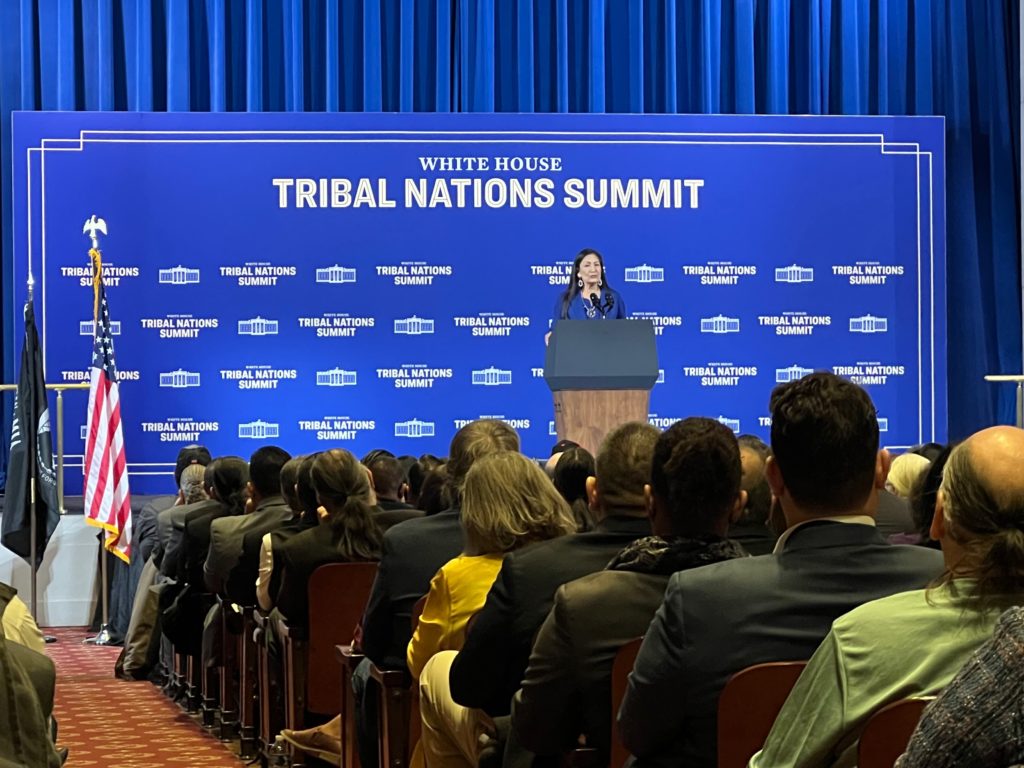There is a growing recognition that many public policy issues are more complex than one sector can address alone. One path towards lasting, systemic change? Public-private partnerships.
Public-private partnerships are not new – the government and the private sector often work together on a shared mission. However, there’s a long way to go in leveraging these types of collaborations to support Tribal Nations and Native-led work.
This week, Native Americans in Philanthropy (NAP) joined the White House and the Department of the Interior to announce a new, historic Office of Strategic Partnerships (OSP).
What is OSP?
Simply put, the OSP is an office that paves the road between the federal government, philanthropy, and tribal communities. OSP will assist with building partnerships with Tribal leaders, philanthropy, nonprofit, and governmental partners, by leveraging resources and bringing awareness of the needs and unique status of Tribal communities focusing on conservation, economic development, and education.
Housed within the Office of the Assistant Secretary - Indian Affairs, the office will work in close coordination with the White House Council on Native American Affairs, , and other federal partners to help Tribes and Tribal organizations develop and build long-term sustainable bonds between philanthropy, non-profit organizations, and the business community.
In the U.S. Department of the Interior’s press release, they note that the new Office of Strategic Partnerships “will work to bring awareness of the needs and unique status of Tribal communities as federal-philanthropic initiatives and programs are developed.”
When was OSP launched?
The new OSP was announced publicly at the 2022 White House Tribal Nations Summit. NAP’s CEO, Erik Stegman, joined representatives from over 300 Tribes to attend the Summit, including a welcome reception hosted by Secretary Haaland. A special event, co-hosted by NAP with the Department of Interior to officially sign our historic agreement and to highlight funders and nonprofit partners working to support Tribal Nations, was held on Friday, December 2nd.
 Secretary Deb Halaand (Pueblo of Laguna) speaks at the 2022 White House Tribal Nations Summit
Secretary Deb Halaand (Pueblo of Laguna) speaks at the 2022 White House Tribal Nations Summit
“At the Department of the Interior we have a solemn duty to honor and strengthen the federal government’s nation-to-nation relationships with Tribes. Today’s announcements reaffirms that commitment and will bring increased and much needed resources to Indigenous communities,” said Secretary Deb Haaland, the first Native American to serve as a cabinet secretary, at the announcement.
 "What an honor to sign our MOU today with the Department of the Interior to create a new Office of Strategic Partnerships. This new office will bring private funders together with government officials to unlock federal dollars for Tribes and make them work better for their communities. I'm grateful to Secratary, Deb Haaland, and Assistant Secratary for Indian Affairs, Bryan Newland, for their leadership." Erik Stegman, CEO of Native Americans in Philanthropy
"What an honor to sign our MOU today with the Department of the Interior to create a new Office of Strategic Partnerships. This new office will bring private funders together with government officials to unlock federal dollars for Tribes and make them work better for their communities. I'm grateful to Secratary, Deb Haaland, and Assistant Secratary for Indian Affairs, Bryan Newland, for their leadership." Erik Stegman, CEO of Native Americans in Philanthropy
Why do public-private partnerships matter for Tribal communities?
There are currently 574 federally recognized Tribes, including 228 in Alaska, and 63 state-recognized Tribes across 35 states. Over the past year, NAP has been engaging in regional listening sessions with Tribal leaders to build a philanthropic movement. By uplifting the perspectives of these Tribal nations, philanthropy can forge meaningful partnerships while also fulfilling a moral obligation to the nation’s first inhabitants.
The federal government has a special trust responsibility and relationship to Tribes that includes programmatic and funding responsibilities. The federal budget for Tribal programs is over $22 billion annually. While philanthropy cannot, and should not, take the place of federal funding or programs and vice versa, the federal government should work with Tribes, Tribal organizations, and philanthropy to help build equitable, long-term solutions to funding access and leverage federal programs. NAP will work to combine the expertise and experience of the private sector with the reach and the scale that only the Federal government can provide Tribal nations.
How can the philanthropy sector engage with this office?
Through OSP, there will be long-term opportunities to develop public-private partnerships to support Tribally-led projects with a focus on the critical areas of conservation, education, and economic development initiatives in Native communities. Native Americans in Philanthropy will continue to work to support philanthropic investment and philanthropic support in the U.S. for Tribal governments, their conservation work, and support co-management efforts through its conservation pledge and funding collaborative.
Many global philanthropic investments in Indigenous movements and Native-led initiatives neglect U.S. based Tribes. Despite underfunding, Tribes consistently demonstrate that they are the best stewards of their lands, waterways, and cultural ways of life using Indigenous ecological knowledge and their unique legal and political relationship with the U.S. government.
Native Americans in Philanthropy would like to share our gratitude for the community of partners who have been in solidarity with our work to increase the visibility of Native people and communities, educate funders, establish meaningful relationships and increase funding to Indigenous-led organizations, movements, and Tribal Nations.
Tags:
NAPDecember 2, 2022
Comments